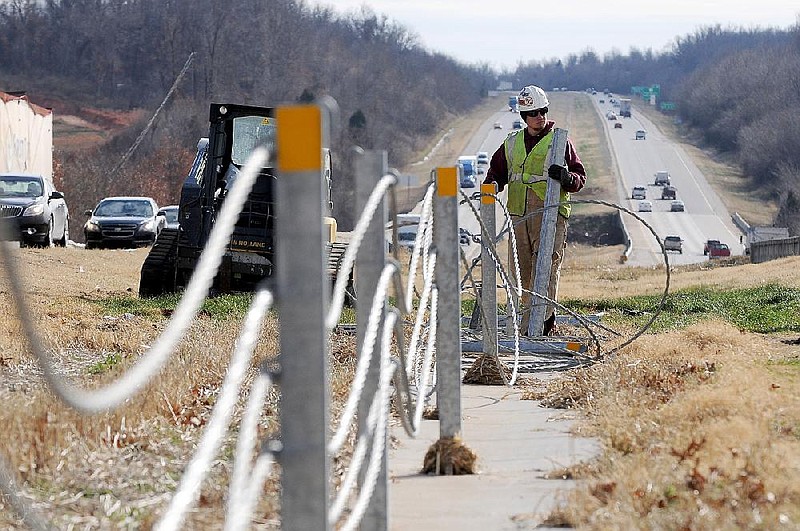Every heap of steel cable drivers see piled in a tangle in the median between northand southbound lanes of Interstate 540 from Fayetteville to Bentonville is a likely a sign of disaster averted when the cable stopped a vehicle from crossing over.
Parts of the steel cables have been damaged more than 70 times since the barrier was completed Aug. 31, according to data from the Arkansas Highway and Transportation Department.
The cable barrier has likely prevented a number of head-on collisions, said Steve Lawrence, the department’s district engineer for District 9, which covers eight counties in Northwest Arkansas, including Benton County.
“Any time somebody hits that thing, there’s a possibility they could’ve gone on into oncoming traffic,” Lawrencesaid. “It’s definitely saved some lives.”
In 2011, the most recent year for which data were available, there were 919 crashes on Interstate 540 between Exit 60 in southern Fayetteville and Exit 86 in Bentonville, including eight that were head-on collisions. The crashes resulted in 13 fatalities and 369 injuries, according to data from the Arkansas State Police and the National Highway Traffic State Administration. The eighthead-on collisions accounted for five of the 13 fatalities.
Each portion of the barrier is made of four steel cables strung between vertical posts that are inserted into a post hole. The cables have between 3,500 and 5,000 pounds of tension, depending on temperature.
Each collision damages the barriers, but the amount of damage varies by accident. While a minor scrape maysimply require tightening of the cables, more severe damage may require new vertical posts and other repairs.
The firm that built the $5 million barrier, Collins and Hermann Inc. in St. Louis, is contractually obligated to execute the repairs until about Feb. 1. The company has made repairs to more than 4,100 feet of cable since the barrier was finished, Lawrence said. The cost of the repairs is $10.50 per linear foot of cable repaired, totaling more than $43,000 in repairs thus far.
While the company is still under contract, motorists involved in collisions with the cable barrier haven’t been charged for repairs of the barrier. Rather, repairs to the barrier have been paid for with federal safety money, which covers 80 percent of projects such as the median barrier cables, as well as repairs to those projects.
The federal safety money fund comes from proceeds of the federal motor fuel tax, which levies 18.4 cents per gallon of gasoline, and 24.4 cents per gallon of diesel fuel. Additionally, Arkansas levies a state motor fuel tax of 21.5 cents per gallon of gasoline and 22.5 cents per gallon of diesel fuel, according to the Arkansas Department of Administration and Finance.
Because Collins and Hermann Inc. isn’t currently involved in a project in the area, it has been sending maintenance crews to do the repairs every few weeks, Lawrence said. That’s meant the barrier might remain crumpled for several weeks before it’s repaired.
After the state releases Collins and Hermann from its contract, Highway Department maintenance crews will begin making the repairs, which will likely reduce the amount of time those take. In addition, the department will begin seeking reimbursement for the cost of repairs to the barrier, Lawrence said.
Randy Ort, spokesman for the Arkansas Highway and Transportation Department, said there are 18 cable-barrier projects under way around thestate, with 28 more scheduled to begin in the near future. In total, there will be 500 miles of median cable barriers in Arkansas at a total cost of about $96 million, he said.
The department recently awarded contracts for three cable barrier projects in and near Fort Smith, projecting to break ground in early spring and completed by the end of this year. These projects include a 5-mile section of U.S. 271 south of Fort Smith and a 5-mile section of U.S. 71 near Greenwood, which together are projected to cost about $950,000. A third bid was let on a barrier on a 60-mile portion of Interstate 40 from the Oklahoma state line to Lamar at a cost of about $4.3 million.
Northwest Arkansas, Pages 7 on 01/17/2013

